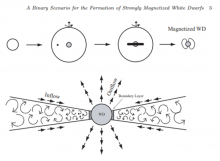
Abstract
Since their initial discovery, the origin of isolated white dwarfs (WDs) with magnetic fields in excess of ~1 MG has remained a mystery. Recently, the formation of these high-field magnetic WDs has been observationally linked to strong binary interactions incurred during post-main-sequence evolution. Planetary, brown dwarf or stellar companions located within a few AU of main-sequence stars may become engulfed during the primary's expansion off the main sequence. Sufficiently low-mass companions in-spiral inside a common envelope until they are tidally shredded near the natal white dwarf. Formation of an accretion disk from the disrupted companion provides a source of turbulence and shear which act to amplify magnetic fields and transport them to the WD surface. We show that these disk-generated fields explain the observed range of magnetic field strengths for isolated, high-field magnetic WDs. Additionally, we discuss a high-mass binary analogue which generates a strongly-magnetized WD core inside a pre-collapse, massive star. Subsequent core-collapse to a neutron star may produce a magnetar.